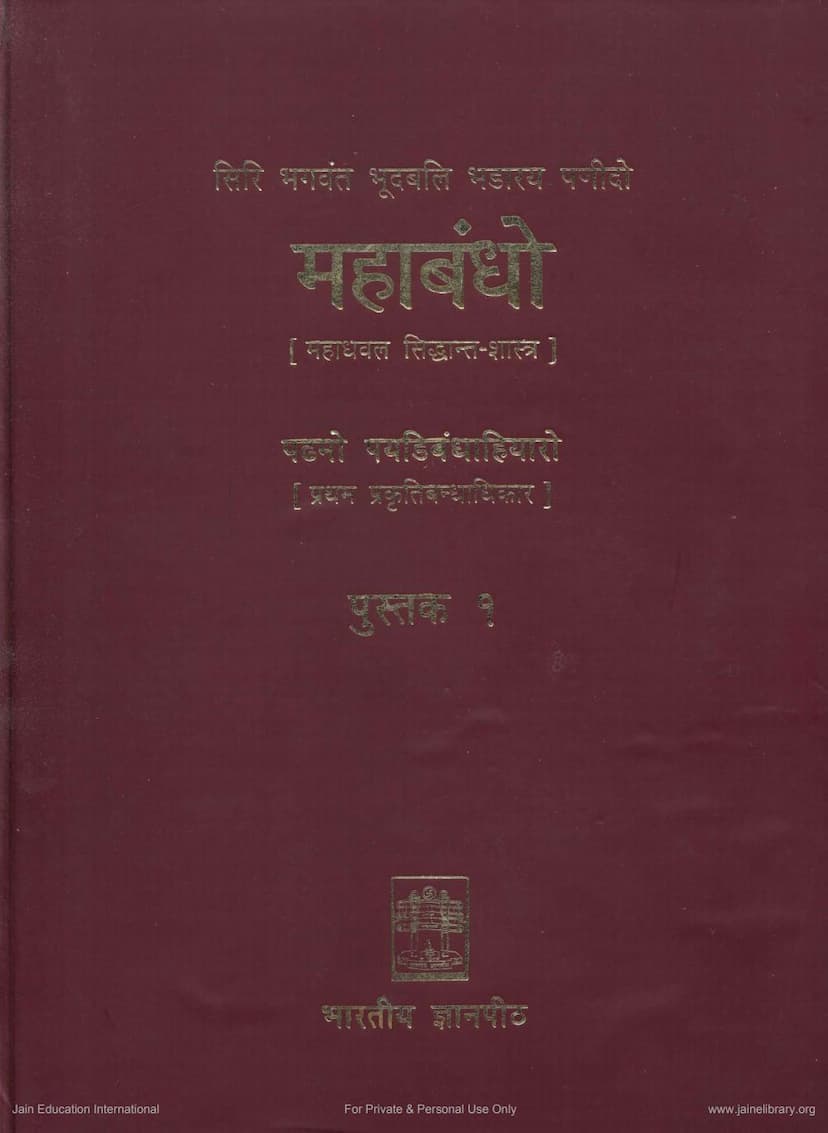Mahabandho Part 1
Added to library: September 2, 2025

Summary
Certainly, here's a comprehensive summary of the Jain text "Mahabandho Part 1," based on the provided information.
Book Title: Mahabandho Part 1 Author(s): Bhutbali (Bhūtabāli) Publisher: Bharatiya Jnanpith Catalog Link: https://jainqq.org/explore/001388/1
Overview of "Mahabandho Part 1"
"Mahabandho Part 1," authored by Bhagvan Bhutabali and edited/translated by Pt. Sumeruchandra Diwakar, is the first volume of the Mahabandho (also known as Mahādhavalā). This work is the sixth section (khanda) of the monumental Jain Siddhanta text, the Satkhandāgama. The Satkhandāgama is considered a crucial text in Digambara Jain tradition, especially since it is believed to contain portions of the lost twelfth Anga, Dṛṣṭivāda.
The Satkhandāgama is estimated to have been composed approximately 614 years after the Nirvana of Tirthankara Mahavira, placing its composition around 73-106 AD. Bhutabali, identified as a Digambara Acharya, is said to have lived around 87 AD, confirming his authorship of significant portions of this work, including Mahabandho.
Subject Matter and Significance:
The Mahabandho is a voluminous work in Prakrit prose (Saurseni with unique features), comprising forty thousand sūtras. Its subject matter is highly technical and deeply rooted in Jain philosophy, particularly focusing on the intricate details of the Karma theory. It is intended for scholars and adepts who wish to delve into the profound and subtle aspects of karmic bondage.
The entire Satkhandāgama, including Mahabandho, is published in seven volumes. The first volume, Prakṛtibandha, specifically deals with the nature of karmic bondage, which is the primary focus of this particular book.
Key Concepts Explored in the Text (as indicated by the introductory material):
- Karma Theory: The text delves into the fundamental Jain understanding of karma, defining it not just as 'action' but as a subtle form of matter attracted to the soul due to desires, passions, and thought activities. It explores the cosmic evolution driven by the soul-matter interaction.
- Classifications of Karmic Bondage: The book meticulously classifies karmic bondage into four primary categories:
- Prakṛti (Nature of Species): This deals with the inherent nature of different karmas, akin to how opium brings intoxication. It explains how karmas manifest in innumerable forms corresponding to the soul's psychic experiences.
- Sthiti (Duration): This classification determines the lifespan of the karmic bondage.
- Anubhāga (Fruition/Intensity): This relates to the potency or fruition of various karmas, influencing the experience of pleasure or pain.
- Pradeśa (Quantity/Space-points): This deals with the quantity of karmic molecules attached to the soul, measured in terms of space-points.
- Prakṛtibandha (Nature of Karmic Bondage): This first volume focuses on the Prakṛtibandha. It explains the 'nature' of karmas, citing analogies like meals transforming into blood, flesh, etc., according to digestive power, and how karmas assume innumerable forms based on the soul's psychic experiences.
- Chapters and Topics: The first chapter (Adhikāra) of Prakṛtibandha is expected to cover topics like Sarvabandha (universal bondage), No Sarvabandha (non-universal bondage), Utkṛṣṭabandha (highest bondage), and Anutkṛṣṭabandha (lowest bondage), among others.
- Philosophical Underpinnings: The text engages with foundational Jain cosmology and metaphysics, including the nature of the soul (Jiva) and matter (Ajiva), the indestructibility of matter, and the Jain rejection of a creator God. It contrasts Jain philosophy with theistic viewpoints.
- Historical Context and Preservation: The publication history, as detailed in the introductory remarks, highlights the immense effort involved in retrieving, editing, and preserving these ancient texts. The Moortidevi Jain Granthamala series by Bharatiya Jnanpith was established with the specific aim of publishing such critical Jain agamic texts. The dedication of Mahabandho Part 1 to the memory of Acharya Shri Shantiasagar Maharaj, a revered Digambara monk known for his spiritual prowess and his efforts towards preserving Jain scriptures (including the idea of inscribing them on copper plates), underscores the sacredness and importance of this work.
- Scholarly Effort: The introductions and prefaces from Pt. Sumeruchandra Diwakar, Dr. Hiralal Jain, and Pt. Devendra Kumar Shastri reveal the extensive research, collaboration, and dedication required to bring this complex text to the public, overcoming challenges like damaged manuscripts and the technical nature of the subject matter.
Structure and Content of Part 1 (Prakṛtibandha):
The first part, Prakṛtibandha, meticulously details the classification of karmas based on their fundamental nature. It aims to explain how these karmic particles, drawn to the soul due to its activities and desires, assume specific forms and qualities that determine their eventual fruition. The author likely employs various analogies and scriptural references to illuminate these abstract concepts. The detailed table of contents indicates a systematic exploration through 24 Anuyoga Dwāras (methodologies of exposition), covering aspects like the nature of karma, universal and non-universal bondage, highest and lowest bondage, duration, influx, quantities, and various classifications.
Overall Contribution:
"Mahabandho Part 1" is a vital scholarly contribution to the study of Jain philosophy, offering deep insights into the complex doctrine of karma, which is central to understanding the Jain path to liberation (Moksha). Its publication makes accessible a profound and ancient text that elaborates on the very fabric of spiritual bondage and the mechanism of rebirth within Jainism.